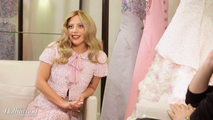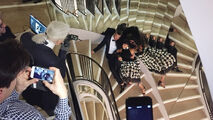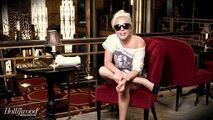
The Hollywood Reporter is a multiplatform American media brand founded in 1930 and focusing on the Hollywood motion picture, television, and entertainment industries, as well as Hollywood's intersection with fashion, finance, law, technology, lifestyle, and politics. Headquartered in Los Angeles,THR is now part of Guggenheim Digital Media, a group of properties that also includes media entities Billboard, Adweek, Back Stage, Sonicbids, the Clio Awards and the Film Expo Group. Under Janice Min, THR was relaunched in 2010 as a weekly large-format print magazine with a revamped, continuously updatedwebsite as well as mobile and tablet editions.
March 27, 2015
At THR, the staff is well-acquainted with things happening last-minute. But the occasion of the cover shoot for this year's 25 Most Powerful Stylists required more scrambling than usual. On March 4, style editor Carol McColgin, who produced and edited the package, got word that Lady Gaga had agreed to be photographed. By Karl Lagerfeld. In Paris during fashion week. McColgin hopped a flight the next day: "All I knew was that Gaga and Lagerfeld were a go for Saturday the 7th, but we didn't know where or when. Which sounds crazy, but not at THR. I was so jet-lagged that I wore trainers to the shoot, which turned out to be at Coco Chanel's apartment. Fashion sacrilege, yes, but wasn't Coco all about liberation?"
This year's Power Stylists issue comes on the heels of an awards season in which a groundswell of substance loudly questioned the validity of style for style's sake (exhibit A: the much-maligned mani cam; and exhibit B:#AskHerMore). Fitting, then, that the talented stylists who made the cut appreciate the importance of their aesthetic guidance in a culture in which fashion trends travel at the speed of a million tweets. Shaping the winning personal and professional styles of, say, Channing Tatum, Kate Hudson, Rita Ora, Emma Stone or Cinderella herself, Lily James, is a damned serious business. Just ask cover subject and style changeling Gaga.
"We don't make a move today without Karl", she gushed during the shoot. "That's the way I am with Tony [Bennett] on the stage — he is the star of the show because he is the legend, and it's the same with Karl" Gaga's suggestion for champagne at the shoot — which included a photograph of her in the same Chanel dress worn by Cindy Crawford in Peter Lindbergh's 1991 "Wild at Heart" Vogue feature — was spot-on. "Being on Coco's couch and having champagne in her apartment — it should always be a moment that we remember", said Gaga. "So we are not just creating fashion as a look but an entire experience. It's our life. It's the reason I do it every day".
- Article by The Hollywood Reporter Staff, photography by Karl Lagerfeld at Coco Chanel Apartment 31, Paris.
August 26, 2015
January 7, 2016
June 2016
- With Diane Warren
November 28, 2018
- Editorial by Ciara McVey, photography by Miller Mobley and Charles W. Murphy.
November 17, 2021 (Issue No. 39)
The singer opens up about the wounds that informed her intense performance as a scorned wife turned murderer, a role that precipitated her own re-traumatization: "I put my entire lifetime into her."
It was a spring day in Rome when Lady Gaga’s sense of reality started to slip. For nine months while preparing for and shooting House of Gucci, Gaga stayed in character as Patrizia Reggiani, who married and ultimately ordered the 1995 murder of Gucci heir Maurizio Gucci. She spoke in a Northern Italian accent even when cameras weren’t rolling on the Ridley Scott film and tapped into her own history of trauma, including being raped by a music producer when she was 19, to depict Patrizia’s unraveling.
One day while shooting a scene with Salma Hayek, who plays Patrizia’s confidant, Gaga was laying on a couch relying on a Stanislavski acting technique (in which she would run through sense memories from an emotional event) when the line between her own experiences and Patrizia’s began to blur. “It’s a scene where I knock a lit candle across the room, and I remember I gave Salma a heart attack that day,” Gaga says. “I was falling apart as [Patrizia] fell apart. When I say that I didn’t break character, some of it was not by choice.” Gaga had experienced this kind of dissociative state before — including once when she was hospitalized. On the Gucci set, Scott intervened, concerned by the impact the performance seemed to be having on his leading actress. “Ridley said, ‘I don’t want you traumatizing yourself,’ ” Gaga says. “And I said, ‘I already have. I’ve already been through this anyway. I might as well give it to you.’ And he said, ‘Well, leave it here and don’t do this to yourself anymore.’ ”
It’s 9 at night in early November in a brightly lit photo studio in Culver City, and Gaga has been posing in dramatic headpieces and gowns for a few hours, occasionally trailed across the room by her attentive hairdresser, Frederic Aspiras, fanning the nape of her neck. She has changed into a loose-fitting royal blue Celine tracksuit for an interview in her dressing room, her hair swept into tidy Princess Leia buns, her hazel eyes often filling with tears as she talks. As a singer, Gaga, 35, has been creating characters onstage and in videos for her entire 20-year career. But in House of Gucci, which MGM will release in theaters on Thanksgiving weekend, she found a new kind of role into which she could channel her considerable real-life heartache, a character driven mad by rejection and hurt. “I took the pain I feel from being attacked when I was a young girl, from feeling left behind by people that I love, from feeling trapped that I can’t go out into a world that I love,” Gaga says. “I took that pain and I gave it to her.”
Her House of Gucci performance is one that will cement Gaga’s place not as a singer who acts, but as an actress full stop, and confirm that her Oscar nomination for 2019’s A Star Is Born was no fluke. The film comes at the end of what has been a busy and, characteristically for Gaga, varied year. In 2021, she released Love for Sale, an album of standards, with her beloved 95-year-old collaborator Tony Bennett, performed a series of jazz shows in Las Vegas and dropped Dawn of Chromatica, an avant-garde remix album of her 2020 dance pop album, Chromatica, in which she teamed with young, mostly LGBTQ artists. In January, she sang the national anthem at President Biden’s inauguration while wearing a bulletproof vest sewn into her Schiaparelli gown (with a huge gold dove brooch), and — in another moment of great national import — in May she performed the song “Smelly Cat” dressed as Phoebe at HBO Max’s Friends reunion.
Sophisticate, chanteuse, patriot, Friend with a capital F: Gaga can become anyone she wants, except a regular person who can walk down the street unrecognized. At times, the weight of that fame is oppressive. “I made a trade when I decided to pursue my career in the way that I have,” Gaga says. “I didn’t know what that trade was going to be, but it happened. And in a lot of ways, I feel like I’ve lost everything.”
If Scott were making House of Gucci 40 years ago, he says, he would have cast Elizabeth Taylor. “There’s that beauty,” Scott says. “And yet there’s an intelligence and a cattiness and a danger to Liz Taylor. And I would compare a lot of this to Stefania.” (Scott calls Gaga “Stefania,” Italianizing her real first name, Stefani, a nod to the actress’ immersion in the Italian woman she plays.) The English director’s company, Scott Free, had been trying to make House of Gucci for nearly 20 years, since Scott’s wife and producing partner, Giannina Facio, bought the rights to Sara Gay Forden’s 2001 book The House of Gucci: A Sensational Story of Murder, Madness, Glamour, and Greed. There was always some barrier — the script was never quite right or studios weren’t interested in a movie that didn’t fit neatly into a particular genre or there was worry of what Gucci, as a company, would have to say about it.
Around the time Scott finally got a script he liked, by Becky Johnston and Roberto Bentivegna, Warner Bros. released A Star Is Born. Up to that point, Gaga had appeared in Ryan Murphy’s American Horror Story, earning a Golden Globe Award, and Robert Rodriguez’s Sin City: A Dame to Kill For and Machete Kills, all roles that capitalized on the flair for drama she demonstrated in her stage persona but none that suggested she could carry a movie. With A Star Is Born, which would end up grossing $436.2 million worldwide and earning eight Oscar nominations, including one for best picture, Hollywood realized Gaga was not just a piece of stunt casting. “A Star Is Born is such a specific thing, and there was always a meta element to the project,” says Bradley Cooper, Gaga’s director and co-star in the musical. “She’s just so terribly charismatic and beautiful. When I met her, I thought, ‘If I can just harness that … then it’s just for me to mess up.’ But then, when we started working together, I realized, ‘Oh, oh, the sky’s the limit in terms of what she’s able to do and her commitment level.’ ”
After seeing A Star Is Born, Scott wanted Gaga for House of Gucci and quickly set up a meeting. “There was only one person ever in my sights at this moment in time who could carry this pretty forthright woman,” Scott says of the role of Patrizia, who, despite a humble upbringing, enchants Maurizio at a party, marries him in 1972 and elbows her way into the Gucci family business, before eventually ordering Maurizio killed when he elbows her back out in their 1994 divorce. “I found Stef to be inordinately approachable and, frankly, a lot of fun. She’s very smart and very, very perceptive. I knew after that first meeting, it was essential that she would do this part. She must. And, of course, because of her very recent success [in A Star Is Born], that made it a lot easier for us to get going and get a proper budget.” (The movie cost more than $75 million.)
Gaga sees Patrizia as a performance of a lifetime — “meaning I put my entire lifetime into her” — and a cautionary tale about what happens to a woman who has been taught that all of her value is in the man whom she marries. In a scene where a family attorney serves Patrizia divorce papers at her daughter’s school, “I yelled at him for every woman on earth, the way that we all do,” she says. “As a woman, I feel like I really can snap into something that’s not about the person that I’m yelling at. It’s like I’m yelling at all the men that came before them. It doesn’t make it right, but it’s real.” Her interpretation of Patrizia is a feminist one — that what drove a woman to murder was going unseen and unheard by the men around her. “I can assure you, you should never put a hit out on your husband,” Gaga says. “But my love and best wishes and my heart go out to all of us women who try to survive and matter in a man’s world. While lots of men were trying to figure out what piece of this pie they were going to get to keep, while they were watching the money, they should have been watching her. And because they didn’t pay attention to her, they lost everything.”
With Gaga aboard, Scott set about winning over the fashion house itself, to be able to use the name Gucci and the clothing archive. “There’s something magic about the word ‘Gucci,’ ” Scott says. “It’s a sexy word that suggests everything that you want to go and see as a form of escapism.” On that front, he had help from some other dynamic women, including his wife: Facio is friends with Hayek, whose husband, French businessman François-Henri Pinault, is the CEO of Kering, the parent company that owns Gucci. Scott reached out to Pinault before going into preproduction, and the executive read the script and had no notes, beyond the word “spectacular,” Scott says. The name and the archive would be made available. Scott rounded out the cast with Adam Driver as Maurizio, the elegant but shy businessman who falls for Patrizia just as he’s preparing to take over the Gucci empire from his father (Jeremy Irons) and uncle (Al Pacino), along with his sometimes bumbling cousin (Jared Leto) and Hayek as a psychic Patrizia consults and ultimately befriends.
For six months before production started, Gaga worked on her accent, which she treated like learning a new musical genre. “If I can sing rock ‘n’ roll or jazz or country or pop music, I knew I could speak in a specific Northern Italian accent,” Gaga says. “It’s knowing how to use your voice, why, and where, and with who, and how to feel while you’re doing it.” She ate more pasta and bread than usual, deliberately gaining weight to have a more rounded figure. “My mother and father met me as Patrizia a couple times,” Gaga says. “And they were mostly laughing because my family gets a kick out of my love of artistry. … There’s a downside to committing yourself to a role in that way because it’s an adjustment for everybody around you. Suddenly, you’re not talking to Stefani anymore with an accent. You’re talking to Patrizia Gucci.” Hayek praises the end result, “the freshness of [Gaga’s] performance and creativity in her choices.” “She was the ultimate professional,” Hayek says. On most days during the three-and-a-half-month production, Gaga woke up around 3 a.m. to begin her transformation, a process that included donning a prosthetic bald cap under her various wigs. Often after she awoke she vomited, from some mixture of “anxiety, fatigue, trauma, exhaustion, commitment and love,” she says. “You wake up, you throw up, you go to set, throw up again.”
Gaga knows that melodrama is part of her brand, but she hopes that people understand she is being sincere when she talks about her total absorption in the role. “I feel so insecure talking about this,” she says. “I get nervous that people will assume that I’m sensationalizing a certain type of acting.”
She also drew upon her family’s Italian heritage that, growing up, often revealed itself around the dinner table. “We had as much food as we possibly could have on the table to celebrate the good fortune that came from hard work and elbow grease,” Gaga says. When her grandparents emigrated from Sicily, she says, they assimilated. For House of Gucci, Gaga says, “I worked a lot on digging into my ancestry and kind of reversing the car, reverse assimilation. How do I get out of the Italian American thing and get myself into what it means to be an Italian woman?” She identified in a core way with Patrizia on the subject of craving parental love and approval. “Part of what makes a good character is knowing what the deep need of the character is,” she says. “But you can’t understand what the deep need of your character is unless you understand your own. My deep need was always to make my father proud. For Patrizia, I think it was to make her mother proud by way of mattering to a man. A man like Maurizio.”
Born Stefani Joanne Angelina Germanotta in New York City, Gaga started playing piano at age 4 and soon learned that music got her what she most craved, which was attention from her father, Joe, a businessman who started a company that sold hotel WiFi and now runs an Italian restaurant on the Upper West Side, Joanne Trattoria. “It’s a bottomless pit,” Gaga says. “I know my father’s proud of me, but my body doesn’t know. When I would sing, my dad would lay on the couch and he would tap his feet and I would play piano. When I sang, I knew I was doing something that my father loved.” Her mother, Cynthia, was a telecom executive and now runs Gaga’s nonprofit, the Born This Way Foundation, and her younger sister, Natali, a fashion designer, has worked on some of Gaga’s projects.
Just as she was studying music as a child, Gaga also was learning acting, including at the Lee Strasberg Theatre and Film Institute, the Circle in the Square Theatre School and, briefly, before dropping out to pursue music full time, NYU’s Tisch School of the Arts. She performed in school plays and booked a tiny role as a high school student in a 2001 Sopranos episode (“The Telltale Moozadell”) but didn’t bring the confidence to acting that she brought to music. “I was terrible at auditioning,” Gaga says. “I was so bad. I could never get a role. I used to just freeze.” One particularly grim episode of camera-induced paralysis happened at a LensCrafters commercial callback. “I would stand there and go, ‘Oh my God. Ah! You’ve got to do this perfect. I’m not making my dad proud.’ ” (She didn’t get the part).
In May of 2020, during the dark early months of the pandemic, Gaga released the house music-inspired Chromatica, her sixth consecutive No. 1 album. Though still a hit, it sold only a fraction of her early dance music albums, like 2009’s The Fame and 2011’s Born This Way. She attributes some of that to the moment, a time when people were scared and secluded at home, not out dancing in clubs. “[The early pandemic] was a time where entertainment was, in a way, so needed,” Gaga says. “But also we just were not fully in the place to receive that. And I think that that’s OK. Sometimes the world is just not in a place to be able to take in art and have it feel good.” Gaga says she struggled with depression while making Chromatica. “That album was so difficult,” she says. “Almost every day that I went into the studio, I didn’t want to be there. When I went into the studio, I used to say, ‘I’m so depressed on a clinical deep level, and I do not want to create anything. I’m not entertained right now.’ … During that time, that music did not make me happy, entertainment did not make me happy, performing did not make me happy.”
As a public figure, Gaga has been unusually open about her health battles, sharing her experience of having fibromyalgia, a chronic pain condition, in her 2017 Netflix documentary Gaga: Five Foot Two and talking about the impact of her rape and a subsequent pregnancy, which she said led to PTSD and a psychotic break, on Oprah Winfrey’s Apple TV+ series The Me You Can’t See, which premiered in May. “It took for me something pretty psychologically damaging happening to me for me to understand how far I had pushed myself,” she says of the hospitalization that happened at the height of her fame. She started her nonprofit, the Born This Way Foundation, in 2011, in part to destigmatize mental health issues for young people, and has partnered with the National Council for Behavioral Health to teach high school students about mental illness and the Yale Center for Emotional Intelligence to survey high schoolers on emotional issues. “She’s helped so many people by telling her own story,” Cooper says. “Anybody that can show their humanity and feel safe doing it, that’s a great thing. I commend her for that.”
Cooper and Gaga grew close during the making and release of A Star Is Born, demonstrating so much chemistry performing a duet of “Shallow” together onstage at the Oscars that fans speculated they might not really be acting. Cooper says they definitely were acting during “Shallow,” which ultimately won Gaga the songwriting Oscar, and he had conceived the performance to unfold like a scene from the movie in part to help manage his own fears about singing live. “Just from a personal standpoint, it reduces the anxiety level,” Cooper says. “They kind of fall in love in that scene in the film. It’s that explosive moment that happens to happen to them on a stage in front of thousands of people. … It would have been so weird if we were both on stools facing the audience.”
Gaga has now sung on the Oscars stage three times and twice at the Super Bowl (including as the halftime performer), but 2021 brought a performance with a new kind of stakes for her — the inauguration, which happened two weeks after the attack on the Capitol and in a month when 3,135 Americans were dying per day from COVID-19. “I had to speak to the country and the world in a different way,” she says. “For that performance, it was through Stefani, meaning myself. And in the world that all went through the last four years together, with Donald Trump. In a lot of ways, I thought to myself, ‘How could I possibly be patriotic?’ I remember thinking that we were at war. And this was a war song. Singing “The Star-Spangled Banner” 5 feet from Mike Pence, 4 feet from George W. Bush, 10 feet from the president-elect, I really realized while I was up there, ‘Oh, that’s right. Not everything is like Donald Trump. We can all be seated in the same place together and be civilized and move forward.’ And I found peace in that. I found that to be orderly. Kindness can be orderly. The government’s not perfect, but we can learn how to behave better.”
Gaga’s boyfriend of about two years is Michael Polansky, who runs Facebook co-founder Sean Parker’s various charities and businesses, and he, together with her three French bulldogs, Asia, Koji and Gustav, make up her home life in Los Angeles. In February, while she was in Rome shooting House of Gucci, two men attacked her dog walker, Ryan Fischer, on the street in West Hollywood, shooting him and fleeing with Koji and Gustav. Fischer recovered from his wounds, the two dogs were returned, and police ultimately arrested five people in connection with the crimes. “Everybody’s OK,” Gaga says. “Everybody’s healing. I pray for Ryan all the time. I’m so grateful that we did not lose him. And every day I thank God for the safe return of my dogs. My dogs and the man that I love are my whole life.” Authorities told her they do not believe Fischer was targeted because he had Lady Gaga’s dogs, she says. “It was random,” she says. “It’s what reminds me that I’m just like everybody else in some ways. We’re all susceptible to these things.”
In many ways, though, Gaga is wholly unique. She has a rare ability to look at herself as an artistic object and see what a filmmaker or photographer sees, in the framing and the composition. “I like her,” she says, pointing at one specific picture of herself among a grouping of a few portraits at the photo shoot. “It’s my job to be a vehicle for the artist to tell their story,” she says, explaining her relationship to the person behind the camera. When it comes to acting, she sees herself as a student. She’d like to improve, and to see how she could bring emotion to a role without allowing it to overwhelm her the way it did on the Gucci set. “I’m actually excited to learn how, and I think that I can,” Gaga says. “I think that that’s my new venture.”
- Editorial by Rebecca Keegan, photography by AB+DM.































